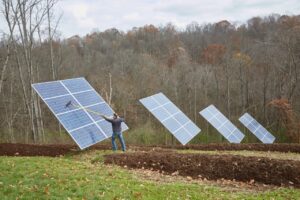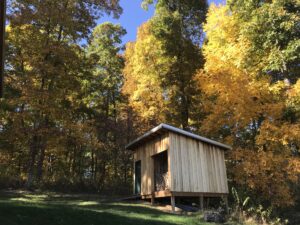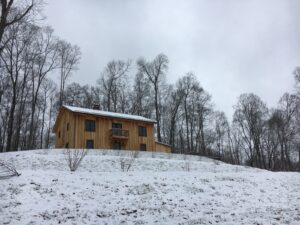Chris Meyer reflects on his passion for creation care, on behalf of Everence and his own family, reminding us how much we all have invested in caring for creation — and how rarely we stop to bask in its glory.
This article was first published in Green Money Journal in February 2024. Republished with permission.
This blog is part of the ongoing Learn, Pray, Join: Climate Justice: Seeking Shalom series. MC USA’s Climate Justice Ministry is sponsored by Everence. Lea la versión en inglés aquí.
 Chris Meyer is the stewardship investing advocacy and research manager at Everence. By day, Chris leads the corporate engagement program for Everence, seeking positive, mutually beneficial change for the planet, people and companies we all rely on. By night, Chris and his family live in a home they built off the grid, with lumber from their property in the hills of eastern Ohio. He enjoys growing much of their food, hunting game in the surrounding woods and even cleaning the snow off their solar array on frigid winter days, so his lights and wireless internet will work.
Chris Meyer is the stewardship investing advocacy and research manager at Everence. By day, Chris leads the corporate engagement program for Everence, seeking positive, mutually beneficial change for the planet, people and companies we all rely on. By night, Chris and his family live in a home they built off the grid, with lumber from their property in the hills of eastern Ohio. He enjoys growing much of their food, hunting game in the surrounding woods and even cleaning the snow off their solar array on frigid winter days, so his lights and wireless internet will work.
_________________________________________________
“The earth is the Lord’s and all that is in it, the world, and those who live in it; for he has founded it on the seas, and established it on the rivers.”
— Psalm 24:1-2 (NRSV)
When I reflect on what motivates me to care for creation, many reasons come to mind. But there is one reason that seems to connect them all: a sense of wonder.
 Where I live, in the Ohio woodlands, early spring is one of my favorite times to be outside and immersed in nature. The temperature is mild, the undergrowth is minimal and the mosquitos aren’t yet biting. Forest flowers will soon bloom, taking advantage of the sunlight that reaches the forest floor before the trees leaf out and shade the ground. Morel mushrooms magically sprout out of the soil; hunting for them is one of my favorite pastimes. These rhythms of nature provide a sense of renewal and assurance in uncertain times.
Where I live, in the Ohio woodlands, early spring is one of my favorite times to be outside and immersed in nature. The temperature is mild, the undergrowth is minimal and the mosquitos aren’t yet biting. Forest flowers will soon bloom, taking advantage of the sunlight that reaches the forest floor before the trees leaf out and shade the ground. Morel mushrooms magically sprout out of the soil; hunting for them is one of my favorite pastimes. These rhythms of nature provide a sense of renewal and assurance in uncertain times.
April is the time for an amazing annual event that occurs on the swollen oak tree buds, ready to burst into leaves. At this stage, for just a few hours, each bud is vulnerable to a particular insect. During this precise time, female gall wasps inject eggs into the oak bud tissue. The process takes only a few minutes. The injections chemically manipulate the bud tissue and cause galls to form as the leaves grow. Galls are the spherical plant growths many of us see on oak tree branches throughout the year. The galls do not harm the oak trees and the wasps are much too small to sting people.
The galls provide both food and protection for the wasp larvae. The larvae pupate inside the gall and emerge as adults in a few months or a year, depending on their type. There are approximately 800 species of gall wasps in North America, each producing unique galls and their own special adaptations with oak trees. Among other distinct features, some galls secrete sweet substances to attract ants, which stay close to the gall and protect the developing larvae from predators. Gall wasps are integral to the lifecycles of many insects and play a vital role in our ecosystem, including as the prey for dozens of arthropods. Who knew?
 I certainly didn’t, until I read “The Nature of Oak” by Douglas Tallamy. The book is organized by the months of the year, with each month as a chapter, and chronicles the various cycles of life that occur in and around oak trees during each period. The level of detail is fascinating. The gall wasp story is only one example of life entwined with oak trees in a book overflowing with them.
I certainly didn’t, until I read “The Nature of Oak” by Douglas Tallamy. The book is organized by the months of the year, with each month as a chapter, and chronicles the various cycles of life that occur in and around oak trees during each period. The level of detail is fascinating. The gall wasp story is only one example of life entwined with oak trees in a book overflowing with them.
Oaks are my favorite type of tree, and I thought I knew a lot about the various species and their attributes and lifecycles. However, Tallamy helped me realize that what I knew only scratched the surface. For instance, I knew virtually nothing about the web of insects sustained by oaks, the insects’ relationships with birds or the centrality of birds to oak regeneration. With each layer I uncovered, my sense of wonder increased. My first thought was, “Amazing!” But as I neared the end of the book, I was left thinking, “What else don’t I know?”
Many people, I’m sure, share my feelings of wonder and humility when encountering the marvels of the natural world, or even upon learning about them in a book. We retreat to nature to experience awe, catharsis and even spiritual renewal. Maybe on a subconscious level this is what draws so many of us toward an ethic of creation care. We’re amazed by what we observe and humbled by what we don’t know. Even the experts only understand a fraction of what there is to know about the natural world.
When we integrate these feelings into our approach to economics, it can have a powerful influence on the world.
Perhaps, if we view nature as an essential part of God’s creation, worthy of its own existence, rather than simply as a commodity to be exploited for human gain, we can develop a more holistic stewardship approach.
When we reduce the natural world to simple inputs for our economies or assets on the balance sheet — or even impediments and obstacles to overcome — we’re selling creation short. Alternatively, a deep appreciation for our environment encourages a long-term outlook over short-term profits or growth at all costs. It fosters a sense of our interdependence with nature.
 At Everence, we believe the natural environment is a finite resource, the inheritance of future generations and a gift from God. Our role is to be stewards of God’s creation, not just consumers of it. We believe that human flourishing requires thriving ecosystems. This perspective infuses our embrace of impact strategies from company engagement to impact bonds to community development investments. We’re working toward a sustainable planet, in which our heirs can enjoy the magnificence of creation and businesses operate profitably, without diminishing the earth.
At Everence, we believe the natural environment is a finite resource, the inheritance of future generations and a gift from God. Our role is to be stewards of God’s creation, not just consumers of it. We believe that human flourishing requires thriving ecosystems. This perspective infuses our embrace of impact strategies from company engagement to impact bonds to community development investments. We’re working toward a sustainable planet, in which our heirs can enjoy the magnificence of creation and businesses operate profitably, without diminishing the earth.
I keep this in mind as I engage companies, as a shareholder representative on a range of creation care issues. We embrace our own ecosystem, working together with environmental advocates, corporate leaders, local communities, other investors and research partners, seeking a more sustainable future for all.
I believe that it’s important for us to think of the natural world as interwoven with our own lives — that we’re in this together. So when it’s time for much-needed perspective, I engross myself in nature and marvel at the wonderous life around me. This provides me with all the necessary motivation to keep caring for creation. And who knows, maybe this spring I’ll be able to catch a gall wasp in the act of laying eggs in an oak leaf bud.
Everence helps individuals, organizations and congregations integrate finances with faith, through a national team of professionals. Everence offers banking, insurance and financial services with community benefits and stewardship education. To learn more, visit everence.com or call (800) 348-7468.

As followers of Jesus, we seek God’s dream of shalom for all people and all of creation, including our climate. Shalom requires that we seek justice and healing for our relationships with God, with one another and with the earth that sustains us.
You are invited to get involved with Learn, Pray, Join: Climate Justice: Seeking Shalom.
Support Mennonite Church USA’s Peace and Justice Initiatives by giving here.
The views and opinions expressed in this blog belong to the author and are not intended to represent the views of the MC USA Executive Board or staff.
Interested in submitting a blog for Menno Snapshots? Please see our blog guidelines here.

